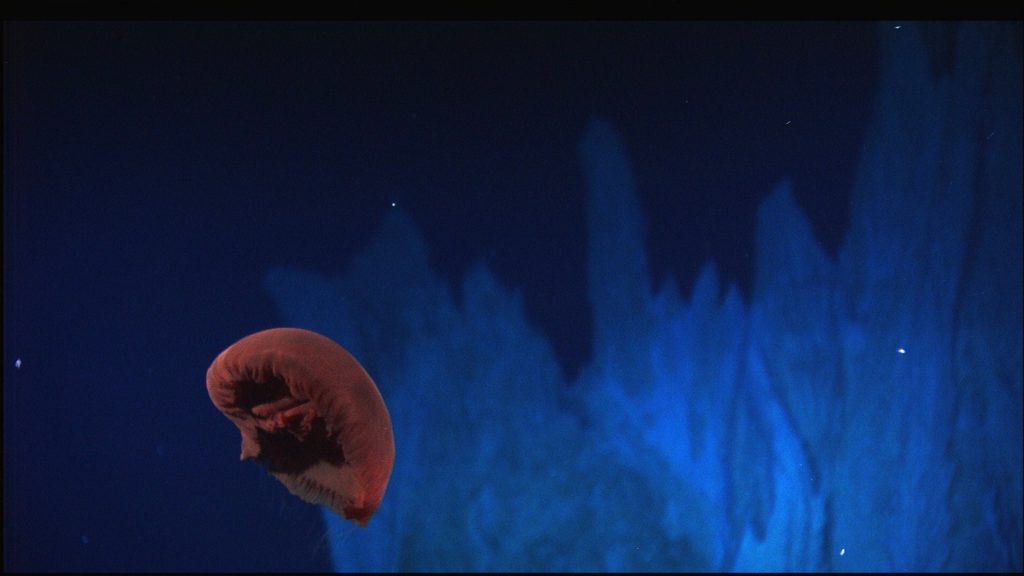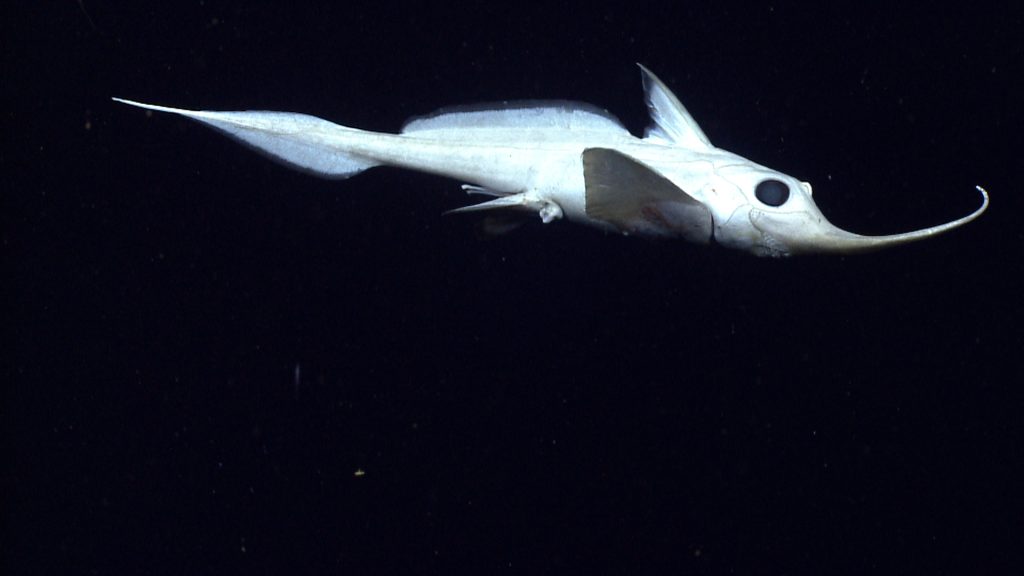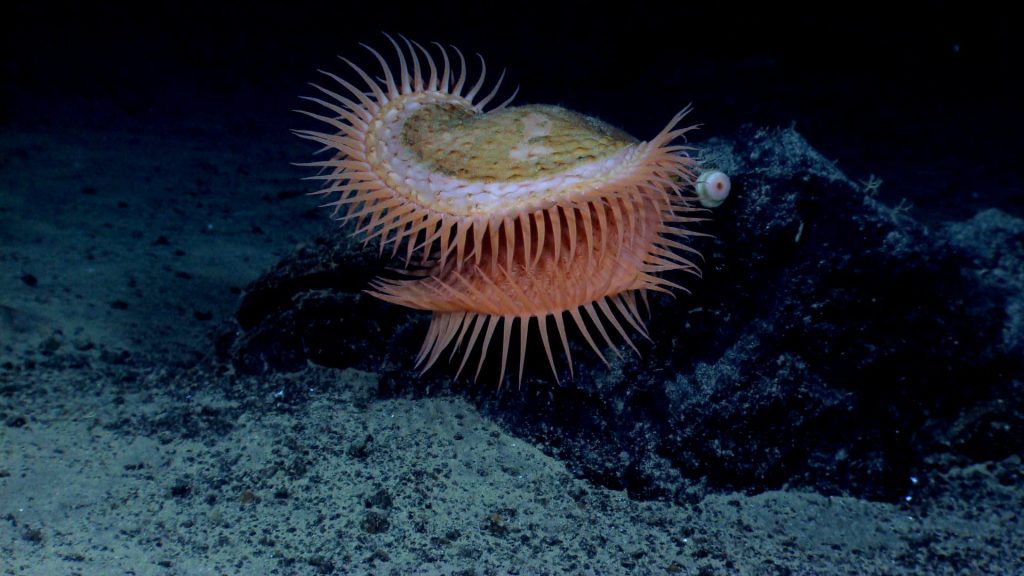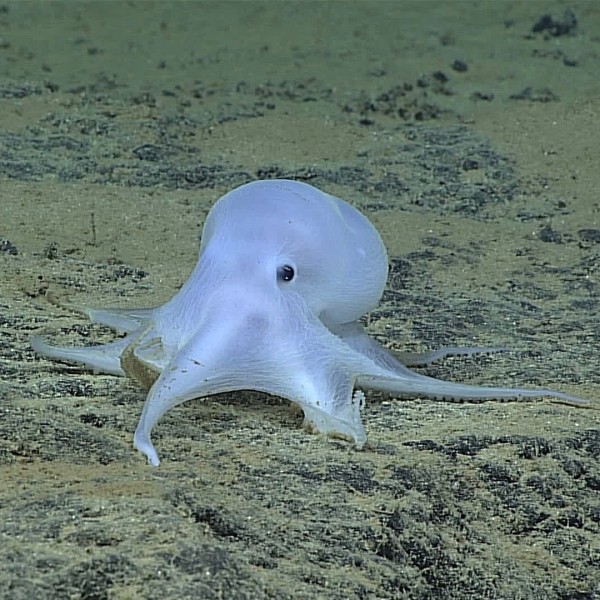Sustainable rattan harvesting: these farmers show that it…
24 April, 2025
Tuesday 26 march 2024
Header photo: © Sian Owen
To start with, deep-sea mining has not begun, so there is no deep-sea mining exploitation anywhere at the moment. But exploration with the intent to start mining has been underway for several years. There are three types of mining envisaged in the deep ocean. One is massive sulfide mining on hydrothermal vents. That is least likely to start any time soon due to the international consensus that hydrothermal vents are incredibly vulnerable, precious ecosystems where many believe life on Earth began. The second type is cobalt crust mining, which would be primarily on seamounts – vast underwater mountains that are epicenters of biodiversity and stopping points for migratory species in their routes across the ocean. The third possible type of deep-sea mining, which is the one that is most in focus at the moment, is for manganese nodules. These are rocks that have accumulated from the base of a shark’s tooth or a small piece of coral that have taken millions of years to form. Across the vast abyssal plains, four to six thousand meters below the ocean’s surface, manganese nodules provide a substrate for countless species to survive and breed on. This is what the miners are targeting.
Why we are opposed to any of this? Our ocean is, as you know, already under tremendous stress from pollution, from the pressures of over- and destructive fishing, and from the impacts of climate change. Our ocean is a key ally in helping adapt to the pressures of climate change; it provides food and it regulates our planetary systems. A healthy ocean is critically important to life on Earth. The last thing we need at this moment of triple planetary crisis is to open a new extractive frontier like seabed mining, which would be the largest mining operation the world has ever seen, in one of the planet’s last wildernesses.

Deep-sea jelly fish, possibly Poralia rufescens © IFE, URI-IAO, UW, Lost City Science Party; NOAA/OAR/OER; The Lost City 2005 Expedition.
I think fundamentally, yes. Scientists are saying that this type of activity would create damage that is irreversible, certainly in human time frames. There is a lot of work going on to assess the potential impact of mining. Prospective miners use words like ‘harvest’ and pretend that they are going to pluck the manganese nodules off the seafloor, but at the moment ‘strip mining’ is much more appropriate a term for what would actually happen. At least the first five to ten centimeters of the seafloor would be scraped away, together with the nodules. And no matter how delicately they remove the nodules, it’s not ‘harvesting’, because these nodules took millions of years to form. They are critical elements of the ecosystem. Removing them would lead to irreversible biodiversity loss.
There are 31 mining claim areas that have been approved so far, 19 of which are for nodules. Each of these 19 claims covers 75.000 square kilometers, and each mine within that claim would be 10 to 12.000 square kilometers. So that is a huge area for mining. Those mining operations would stretch across 30 years, 24 hours a day, 7 days a week. Imagine resulting the noise and light pollution, and plumes of sediment-filled, potentially toxic waste water released in the mid-water column above, and you start to get a sense of the scale of that impact. So yes, I think it would very much qualify as ‘ecocide’.
I had been working in ocean conservation for almost a decade before I got involved with the DSCC. I worked for Ocean Desert Enterprises with Sir Wouter van Dieren for a couple of years, and then for WWF’s Global Marine Programme. Late in 2010 the Co-Founder of the DSCC called and asked if I wanted to coordinate the campaign planned for 2011. So I joined for a year 13 years ago and am still going strong. The Coalition started out campaigning to end deep-sea bottom trawling in the areas beyond national jurisdiction – a battle we are in the final stages of winning. A moratorium on deep-sea mining is the other major focus of our work to address the greatest threats to deep ocean health.
The most important element of the Coalition’s deep-sea mining moratorium campaign is at the International Seabed Authority (ISA). It is governments – the ISA Member States – who are ultimately going to decide whether or not we mine the deep seabed. The ISA is the UN affiliated body, based in Kingston, Jamaica, which, under the Law of the Sea Convention, has the mandate to regulate the deep seabed. Its mandate is twofold: both to protect the environment for the benefit of humankind and to regulate any mining activities on the seabed in the Area outside national jurisdiction. These two parts of its mandate are contradictory. The challenge that we face is that for the last two or three decades, negotiations have been going on at the ISA, on the assumption that mining is going to take place. So we need to work both within and beyond that forum on government decision makers, to take on board the new science and new information available, to make the right political decisions and change course.

A Rhinochimaera © NOAA OKEANOS Explorer Program , 2013 Northeast U. S. Canyons Expedition
There’s two parts to that answer. The DSCC’s work is focused on international waters – the fifty percent of our planet that is high seas and that is regulated through the ISA and other bodies that have oversight mandated by the UN. The High Seas Treaty for the protection of biodiversity in areas beyond national jurisdiction was adopted last year in March. The Treaty will come into force once sixty or more countries have ratified. So that will be really important for governance of the whole ocean, including the deep seabed.
The other part of the answer of how deep seabed mining would be regulated is within national waters. Each country with a coastline has its own exclusive economic zone, and they have the right to manage all activity in their waters. Some countries, like Norway, Japan, Portugal and New Zealand have the potential to mine the deep ocean in their own waters. If they choose to go ahead, that would be regulated through their own legal systems.
There is growing opposition to deep-sea mining all across society. Two years ago, not a single government had stepped forward to call for a moratorium on deep-sea mining. Then in June 2022, at the UN Ocean Conference in Lisbon, the president of Palau called for a moratorium on deep-sea mining and launched an alliance of countries around this goal. The Prime Minister of Fiji committed his country as the second member of this alliance, and then the UN ambassador from Samoa took the floor and committed Samoa as well. Fast forward to today, we have 25 governments who are calling for either a moratorium, ban or precautionary pause. The language is less important than the intent. This group of countries has grown very quickly and now includes Spain, France, Germany, the UK, Mexico, Canada, Chile, Costa Rica, and importantly, a growing number of Pacific Island countries who were, of course, the first to launch this powerful movement.
The ISA is holding its next Council Meeting from 18-29 March. That will be a moment for new countries to step forward with a moratorium call. Important to growing this political will has been the pressure coming from companies. Some of the major tech companies like Google, and car companies like Renault, Volkswagen and BMW, are stepping forward and saying ‘We will not be using metals from the deep sea in our value chain, period.’ Equally, we have finance institutions, such as Triodos Bank and ABN Amro, saying that they will not lend to, or finance, activities for deep-sea mining. A number of fisheries organizations, both small and large, have also called for a moratorium.
Indigenous leaders from communities around the world are saying ‘this is not in keeping with our cultural values. The ocean is critically important to us, culturally and traditionally. It feeds us, it nurtures and sustains our communities and our way of life. We do not accept this going forward and you do not have social license from us for this’. Among the calls from civil society groups around the world are messages from church leaders such as Reverend James Bhagwan, who is the Head of the Pacific Counsel of Churches and represents 8 million voices across the Pacific region. The pressure to press ‘pause’ is tremendous, and across the board.
At the ISA, Norway has long been one of the countries pushing to open the deep ocean, to adopt a mining code to let mining go ahead, to accelerate all of these processes. Norway has also long exploited its own waters for oil and gas and made a lot of money. Now that Norway is seeking to defossilize, it needs to produce something, economically, so there is a financial question that it is seeking to answer. Additionally, they have oil and gas infrastructure that they are seeking to repurpose. But while there is a strong and vocal group within Norway pushing deep-sea mining as the answer, there has also been a mighty counter force to deep-sea mining within Norway. Civil society protest has been huge, and the Norwegian Academy of Sciences has said ‘No, we should not go ahead with this, there is far too little known about the impacts that this is going to have.’ All the arguments that have fueled the call for a moratorium elsewhere, are also being positioned in Norway by important scientific and political voices. The area that they have opened for exploration is about the size of the Netherlands, Luxembourg and Belgium combined. If that exploration delivers the results that they are hoping for, then exploitation would have to be approved by Parliament as a next step. It is hard to imagine, once all of that money is being invested in exploration, that it would be easy to say ‘no’ to exploitation licenses.
But what happened the following month was a fantastic political pushback from the European Parliament. The vote on February 7 adopting a resolution critical of Norway’s decision is an important affirmation of previous calls by the European Parliament for a pause on deep-sea mining.
What’s your view on the narrative that we need deep-sea mining to have enough critical minerals for the energy transition?
The narrative that we need to open the deep sea to mining to meet our net-zero pathway goals is complete greenwash. Fortunately, it is being increasingly negated by reports that are coming out, almost every month now, demonstrating that we can meet our net-zero ambitions without opening the deep sea to mining.
How will we meet the transition goals without mining the deep sea? We must first and foremost invest in the circular economy. We need to improve our use of the metals that we have already extracted. Reduce, recycle, reuse, redesign – we need to get much better at all of it. Policy needs to incentivize investment in those areas. We are also seeing rapid innovation on the tech side in terms of reducing the amount of metals that we are going to need for energy storage and battery storage and transmission. A few years ago, cobalt was the metal in focus, but now company after company – including Elon Musk and BYD, the big Chinese battery maker – are saying that cobalt is largely irrelevant. The same thing is happening with nickel, another key target metal in the deep ocean. Money spent on tech innovation is having tremendous returns in terms of reducing our need for virgin metals.
There is zero evidence that deep-sea mining would ever replace terrestrial mining (which is another line of greenwash being peddled). So where we do still need new minerals, attention should go to ensuring the necessary improvements in existing mines on land. Mining has been a massively destructive sector. What we hear from civil society groups working on those issues, is that if terrestrial mining was improved along environmental, social and governance standards, it could be a productive sector to provide livelihoods and economic benefits to communities and countries. But it needs to be run much better than it is today. That’s a matter for responsible investment, not opening up a new frontier of destruction.
Finally, just to note – if deep-sea mining went ahead, the benefits would be concentrated in the hands of a few rich people in the Global North. Rather than providing benefit to humankind as a whole, leading economists are telling us that it would be another example of costs being borne by society and profits reaped by the rich few.

Venus flytrap anemone © NOAA Okeanos Explorer Program, INDEX-SATAL 2010, NOAA/OER
What are the biggest challenges to stop deep-sea mining from happening, and how can we overcome those challenges?
The biggest challenge is the status quo. That has two main aspects. One is the capitalist, extractive model of how our economic system functions – the assumption that “we need more and the Earth will provide infinitely for our needs”. Within that challenge is the dichotomy of need – some people do actually require more to meet their basic needs. However, among other groups, the rate and scale of consumption must be reduced if we are to live within planetary boundaries. We need to completely rethink how we are going to meet our future needs for mobility, for energy, and so forth – basically transformational systems change. The ‘we need to go and mine the deep sea’ narrative very much fits into an anachronistic, extractive model of economic growth that no longer works.
The other status quo challenge is within the ISA itself – a body that was created 30 or so years ago. The political mentality within that institution is, ‘we are here to open up the deep sea to mining, and it is not a matter of if, it’s a matter of when’. So we need to push back on that status quo as well.
How to overcome these challenges? Have these conversations. Build awareness. Bring the momentum of public opinion to bear. We need to make people care. In the same way that we managed to protect the ozone layer by phasing out the ozone-depleting substances, and we managed to take lead out of petrol in the 1970s and 1980s, if people care enough about this, we can shift the paradigm. And increasingly people do care, which is why we now have 24 countries calling for a moratorium, and millions of voices around the world urging their governments to make this call. We will succeed, because people are suddenly waking up and understanding the threat. We can make changes in our behaviour and force our companies and our governments to make changes in the way that they operate, if we just mobilize.
The position of the Dutch government is very much a “polder” approach. There are a number of ministries that are involved – Foreign Affairs and Economics, and Agriculture and Fisheries and Ocean and the Environment. Each comes from a different perspective. Some are more focused on the environmental protection and all of the commitments that the Netherlands has made to ocean and environmental conservation, and the Sustainable Development Goals. These forces are driving the Netherlands toward a precautionary pause position. On the other side are voices in government saying, “We don’t have these minerals, if they are out there, we would like access”. The Dutch government is calling for strong regulations and saying that any mining that took place, would need to be under a set of strong regulations. But that position is problematic because it doesn’t acknowledge that there is simply no such thing as “sustainable mining” in the deep ocean. That said, the Dutch government has been wonderfully supportive of the right to peaceful protest against deep–sea mining, which is an important element of raising public awareness worldwide around the issue. So that is much appreciated.
One way your readers can help influence the Dutch government is by signing the Bottom Line! petition “Set limits on mining for a just energy transition’, in which we ask the Dutch Parliament to urge the government to join the alliance of countries calling for a moratorium on deep-sea mining.
I was in the Scheepvaartsmuseum recently, and one of the exhibitions is a beautiful story about the human perception of whales. Hundreds of years, ago we were scared of these “sea monsters”, and of course for fishers they were particularly scary because the boats were so small and the animals were so big. And then along came bigger vessels, and the rise of the whaling industry with people killing whales by the thousands in the 19th century for corsets, umbrellas, oil and so forth. Then, more or less from mid-20th century, we started treating these animals as the beautiful and sentient mammals that they are, and putting in place protection measures. Whales travel great distances, and their migratory routes take them deep through the ocean. One of the threats of deep-sea mining is the sediment and the toxic plumes that would be returned into the water from the ship after whatever was mined from the ocean came up to the ship. That, along with the noise and light pollution, could have tremendous impact on them. This is why the Convention on Migratory Species conference, that met in Uzbekistan in February, passed a strong resolution condemning deep-sea mining.
Secondly, at the bottom of the deep sea lives a species called the Casper octopus. They are tiny little octopuses who look like ghosts. The female octopuses breed on sponges that grow on manganese nodules. She lays her eggs on that sponge and then she stays on the sponge and nurtures her eggs. And while she nurtures the eggs and they grow, she can’t go anywhere anymore and all of her energy and strength go into these eggs. After several years, a host of little baby Casper octopuses is born and the mother dies. Without the nodules, the sponges would not grow, and without the sponges, the octopuses would have nowhere to lay their eggs.

Casper octopus, © NOAA Office of Ocean Exploration and Research, Hohonu Moana 2016.
I spent my childhood in Indonesia. I grew up snorkeling and when I was old enough, scuba diving. Some of my happiest moments are in the water. I’m blown away every time I go under and get to be part of that three-dimensional ecosystem. I am driven both by that passion and that joy, and as well by an outrage of how we treat the ocean. It was one thing to cause so much harm when we didn’t know better. But now we know better and we have a responsibility to act on the knowledge that we have and take care of our planet.
During meetings of the ISA Council or Assembly, we have a team on the ground that is tightly focused on the work at hand. Conscious of wanting to minimize our carbon footprint, we keep that team as small as possible, with back-up from the wider team around the world. We are also always connecting the political messaging and outreach from the conference back to the capital cities around the world where often the decisions are actually being made. On the ground, the schedule is intense. We typically wake up early and hold internal meetings to debrief on the previous day and line up for the day ahead. Then we go into plenary and follow the negotiations. The Member States sit in the main part of the plenary hall and we are up to one side in the Observer seats. We will usually have the right to raise our hand to intervene, once all of the countries have had their say on that agenda item. In the lunch breaks and at the end of the day, we attend side events or set up meetings with target country delegations. Sometimes we also organize side events to bring more information on the science or on new reports published on various aspects of the issue.